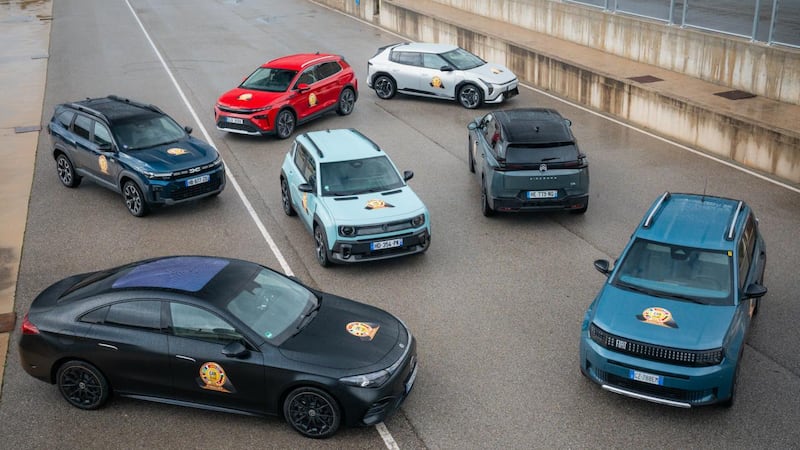Apple once had grand aspirations to build its own electric self-driving car and lead the next generation of transportation. Over time, the tech giant's ambitions ran into the reality.
So Apple curtailed its original vision, first by focusing on software for self-driving cars and then by working solely on an autonomous shuttle for its own use with employees.
Now, the tech giant has settled for a car partner that was not its first choice. In recent years, Apple sought partnerships with the luxury carmakers BMW and Mercedes-Benz to develop an all-electric self-driving vehicle, according to five people familiar with the negotiations who asked not to be identified because they were not authorised to discuss the matter publicly.
But on-again, off-again talks with those companies have ended after each rebuffed Apple’s requirements to hand over control of the data and design, some of the people said.
Instead, Apple has signed a deal with Volkswagen to turn some of the carmaker’s new T6 Transporter vans into Apple’s self-driving shuttles for employees – a project that is behind schedule and consuming nearly all of the Apple car team’s attention, said three people familiar with the project.
Travails
Apple’s deal with Volkswagen and the failure of its talks with other carmakers reflect the continuing travails and diminished scope of the company’s four-year-old car programme.
The project has suffered from repeated changes in direction that have hurt morale and led to hundreds of departures from its peak of more than 1,000 members two years ago, five former Apple employees said.
They added that the project lacked a clear plan beyond the vans, including any near-term commercial goals.
The fits and starts have most likely put Apple even further behind in the race toward the self-driving future. Waymo, the self-driving business spun out of Google, as well as startups and some carmakers have been testing various autonomous vehicles on public roads for years.
Some of the programmes have hit hurdles but many have already gathered extensive data on autonomous driving patterns to improve their technology. Apple declined to comment.
Apple originally began its car project – known internally as Titan and T172 – in 2014. At the time, Apple planned to build a single vehicle that would upend society and industry, in what would be the automotive version of the iPhone. The company set to work on an electric driverless car with a lush interior reminiscent of a lounge or living room, where passengers face one another instead of the road, according to two early employees of the project.
Apple enlisted software programmers, automotive engineers, rocket scientists and the industrial-design team of Apple's design chief, Jonathan Ive, to reimagine the car.
Machine shop
They entertained a series of unconventional concepts, including augmented-reality or holographic displays embedded in windshields and windows, a sunroof made of a special polymer that reduces heat from the sun, and windows with adjustable tints – like those on Boeing’s new 787 Dreamliner jets.
Two former Apple employees also recalled how their colleagues built a model of an SUV with four seats facing one another, which some employees tested by sitting inside, similar to a design Mercedes advertised in 2015.
As recently as 2016, Apple planned to spend hundreds of millions of dollars to build research and development labs around its Cupertino, California, campus, including a machine shop and labs for electric car batteries, according to interviews and documents about the plans viewed by The New York Times. Yet members of the car project soon found that even designing and building fundamental parts of a new car was not simple.
Apple initially intended to build the car in-house, with preliminary discussions of an Apple automotive plant in the south of the US, two former employees said. But those plans quickly shifted to finding a manufacturing partner to build – but not design – the cars.
Two former employees said Apple’s requests of partners gradually evolved. At first, the company asked for help building an Apple-designed vehicle. Then, it began asking potential partners to provide foundational car pieces like the chassis and wheels.
Eventually, Apple requested that potential partners retrofit their own vehicles with Apple’s sensors and software. In late 2015, Apple bought two Lexus SUVs and hired a Virginia firm called Torc Robotics to retrofit the vehicles with sensors, a project known internally as Baja, one former employee said.
The fleet has grown and California regulators have authorised Apple to use 55 such SUVS to run self-driving tests on public roads, the most of any company in the state after General Motors – but still fewer than Waymo has across six states.
Code name
Late last year, Apple found a partner in Volkswagen. Buffeted by a scandal around cheating emissions tests – and lagging behind some rivals in development of self-driving cars – Volkswagen jumped at the chance to work with Apple, former Apple employees said. Volkswagen’s code name at Apple is Jetstream, one said.
Now, at a lab near Turin, Italy, run by a Volkswagen subsidiary called Italdesign, the companies plan to remake Volkswagen's T6 vans as electric self-driving shuttles, these people said.
The frame, wheels and chassis of the T6 vans will remain, but Apple is replacing many components, including the dashboard and seats, said two people familiar with the project.
Apple is also adding other computers, sensors and a large electric car battery, they said. The shuttles will ferry employees between two of Apple’s Silicon Valley campuses, and will include a driver behind the wheel to take control if needed, as well as an operator in the passenger’s seat tracking the van’s performance.
Executives leading Apple's car project had told CEO Tim Cook that the shuttle would be completed by the end of 2018, but that deadline will be missed, one former employee said.
It is unclear whether Apple’s partnership with Volkswagen will extend beyond the shuttle. – The New York Times News Service















